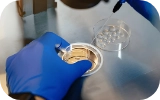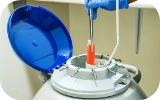Guide to Fertility Testing and its Types

Infertility is a common issue faced by many couples. The condition is defined as a couple's inability to conceive despite having unprotected, well-timed sexual intercourse for over a year. Infertility can be treated but for this, it is important to first identify the causes. This is where fertility testing comes in.
What is Fertility Testing?
Fertility testing is the first stage of treatment for infertility. This is used to assess the problem that is not allowing the couple to conceive. Fertility testing applies to both men and women. The tests begin with understanding the couple's medical history and lifestyle followed by a few other tests.
Types of Fertility Tests
- Blood Tests - This is usually the first test to be conducted. It is used to check the levels of hormones in the body and to screen for a disease that could affect fertility such as chlamydia and rubella. Some blood test may be scheduled around the woman's menstrual period.
- Pelvic Examination - Here the doctor will check for signs of sexually transmitted diseases that could interfere with pregnancy.
- Semen Analysis - This tests the quality and quantity of the sperm present in the semen. It is also used to check sperm motility.
- BBT Charting - BBT charting involves recording basal temperatures to check ovulation.
- Post Coital Test - The couple may be asked to have sexual intercourse and visit the doctor a few hours later. A sample of cervical mucus is then tested for the viability of the sperm and to see how it interacts with the cervical mucus.
- Transvaginal (pelvic) Ultrasound Exam - An ultrasound may be advised. This test allows the doctor to see the ovaries and uterus. This type of ultrasound gives the doctor an idea of how the follicles within the ovary are functioning. It is usually performed 2 weeks before a woman's menstrual period.
- Hysterosalpingogram or HSG - This is a series of X rays of the fallopian tubes taken after injecting a liquid dye into the uterus through the vagina. It helps detect blockages in the fallopian tubes and uterine defects.
- Hysteroscopy - A hysteroscopy involves inserting a thin, flexible tube through the vagina into the uterus to allow the doctor to look into the uterus and check for any issues that could be causing infertility.
- Laparoscopy - A laparoscope is inserted through an incision in the abdomen to look for endometrial scarring in this test. This test is performed while the patient is under general anaesthesia.
 Infertility Counselling
Infertility Counselling Female Infertility Treatment
Female Infertility Treatment Andrology Treatment
Andrology Treatment Fertility Enhancing Surgeries - Female
Fertility Enhancing Surgeries - Female Fertility Enhancing Surgeries - Male
Fertility Enhancing Surgeries - Male Endoscopy Treatment
Endoscopy Treatment IUI Treatment
IUI Treatment IVF Treatment
IVF Treatment ICSI Treatment
ICSI Treatment Advanced IVF Solutions
Advanced IVF Solutions Embryology
Embryology Vitrification Egg, Embryo, Sperm Freezing
Vitrification Egg, Embryo, Sperm Freezing Preimplantation Genetic Testing (PGT)
Preimplantation Genetic Testing (PGT) Donation Program Embryo / Egg / Sperm
Donation Program Embryo / Egg / Sperm Self-cycleTM IVF
Self-cycleTM IVF

 Self-cycleTM IVF
Self-cycleTM IVF









